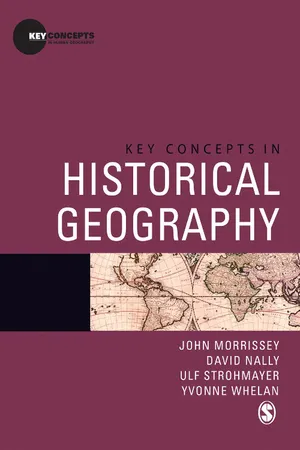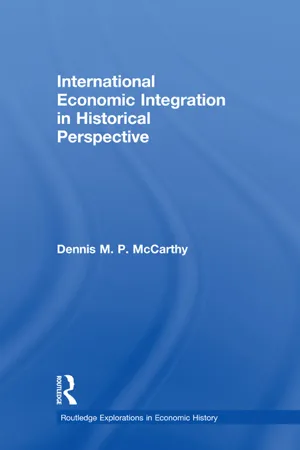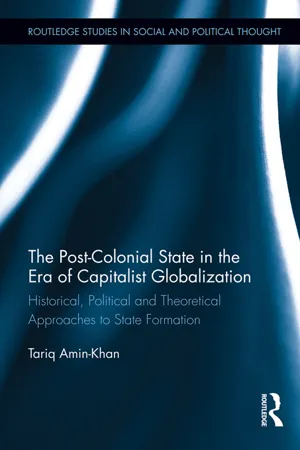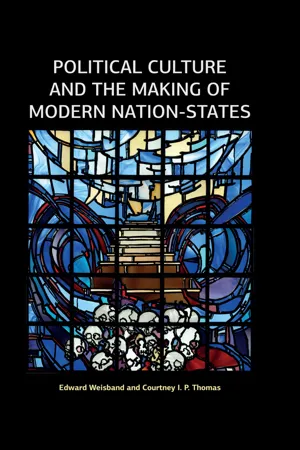History
Colonial Empire
A colonial empire refers to a group of territories or regions that are controlled and exploited by a powerful nation, known as the colonial power. This control is often achieved through military conquest or political dominance. The colonial empire typically involves the extraction of resources, imposition of cultural and social systems, and economic exploitation of the colonized territories.
Written by Perlego with AI-assistance
Related key terms
8 Key excerpts on "Colonial Empire"
- eBook - ePub
- John Morrissey, David Nally, Ulf Strohmayer, Yvonne Whelan(Authors)
- 2014(Publication Date)
- SAGE Publications Ltd(Publisher)
Section 1 Colonial and Postcolonial GeographiesPassage contains an image
John Morrissey1 IMPERIALISM AND EMPIREIntroductionFrom the expeditions to the Americas in the fifteenth century through to the interventions in the Middle East in the twenty-first century, imperialism has indelibly marked modern times, forging human geographies on every continent and leaving legacies still seen and lived to this day. As Robert Young notes, the ‘entire world now operates within the economic system primarily developed and controlled by the West, and it is the continued dominance of the West, in terms of political, economic, military and cultural power that gives this history a continuing significance’ (2001: 5). Moreover, given the ongoing wars prosecuted in the name of Western civilization in the world today, Derek Gregory prompts us to recognize ‘the ways in which so many of us continue to think and act in ways that are dyed in the colors of colonial power’ (2004: xv). This chapter initially sets out the ideologies and discursive mobilities of imperialism before reflecting on approaches to its study in historical geography, while the subsequent chapter examines the complex geographies of colonialism and anti-colonialism forged and contested throughout the world as a result.Defining ImperialismImperialism can be defined as a system of power, political economic ascendancy and cultural subordination, envisioned from the centre of expanding nation-states and differentially operationalized in colonized spaces throughout the world. Definitions are always fraught with difficulties, of course, and it is important to recognize the complexities of the terms empire, imperial and imperialism, which have been shown to have connoted different historical cultural meanings and political realities through time (Loomba, 1998). In general terms, imperialism has historically operated in various forms. As Dan Clayton outlines, there have been ‘over 70 empires in history’ (2009a: 189). Temporally, these comprise ancient, medieval, early modern, modern and contemporary, and geographically include, for example, the former Inca, Greek, Roman, Chinese, Ottoman, Spanish, British, Japanese and Soviet empires. Differentiating models of empire is hugely problematic; there has been considerable debate concerning the extent to which colonial expansion was state-driven and centred, for example (Hardt and Negri, 2000). That said, three key variants of state-driven imperialism on a global - Dennis Patrick McCarthy(Author)
- 2006(Publication Date)
- Routledge(Publisher)
1 Colonial EmpiresImperialism and Colonialism: Types, Causes, and FormsMany Colonial Empires have come and gone over the last 2,000 years. Colonial Empires are associated with colonialism, which is directly related to imperialism. Imperialism is a broad term that encompasses whatever leads some people to dominate others. Imperialism pertains to an empire as a whole, whereas colonialism focuses on the individual colonies that an empire possesses. Colonies are the territories seized by an empire and can become administrative units of it.Imperialism has many causes. The drive to acquire power, money, wealth, or territory can be rooted in economic, business, political, religious, social, psychological, and cultural considerations. An empire usually runs on several sources of motivation and particular empires have their own distinctive mixes of these factors.The term empire can refer to a number of situations. Many empires throughout history have developed a strong bureaucratic or administrative dimension. In many cases the dominating country maintained physical control over its subject lands and peoples by setting up administrations in their territories. Civil servants or military personnel or both could run these bureaucracies. The Colonial Empires of Great Britain, France, Germany, and Portugal followed this pattern. Japan wanted its own colonies in the twentieth century and maintained a military occupation of Korea from 1910 to 1945.Administrative empires need not be associated only with governments. Religious and criminal empires are creations of people not in government. But they exhibit the essential characteristic of empire building: a core group wants to extend its power and influence over other people and places. These empires develop their own organizations that cross international borders and, in this sense, they are administrative empires.Empires need not be administrative or even formally organized. In this regard the notions of informal imperialism, economic imperialism, economic colony, and sphere of influence are all important. Formal imperialism is usually associated with governments creating their own bureaucracies to administer their individual colonies. Informal imperialism designates a spread of power and influence that does not take shape in official or government organization. Informal imperialism can prepare the way for formal imperialism by setting in motion a dynamic that will compel a government to extend its administrative apparatus outside its national borders. But a crucial point is that informal imperialism does not inevitably produce formal imperialism. Whether or not that transformation occurs depends on the particular techniques employed by those engaged in a specific case of informal imperialism.- eBook - ePub
Postcolonialism
An Historical Introduction
- Robert J. C. Young(Author)
- 2016(Publication Date)
- Wiley-Blackwell(Publisher)
de facto distinction is being made between the two, yet a characteristic of postcolonial writing is that the terms ‘colonial’ and ‘imperial’ are often lumped together, as if they were synonymous terms. This totalizing tendency is also evident in the way that colonialism and imperialism are themselves treated as if they were homogeneous practices. Although much emphasis is placed on the specific particularity of different colonized cultures, this tends to be accompanied by comparatively little historical work on the diversity of colonialism and imperialism, which were nothing if not heterogeneous, often contradictory, practices.Both colonialism and imperialism involved forms of subjugation of one people by another. The world has a long history of such kinds of domination. Traditionally, forms of empire tended to concentrate on expansion within a single land mass; for example, the Chinese empire, or, even more striking, the empire of the Moors which, at its zenith, stretched from Vienna to northern Spain – the long way round, via northern Africa. Similarly, the Roman empire, which nineteenth‐century imperialists frequently invoked as the guiding model and moral justification for their own activities, expanded from the centre, Rome, and pushed outwards, gradually becoming so unwieldy that it fell in two, continuing in various subsequent incarnations, such as the Byzantine and Holy Roman empires, in the form of a single land mass. This geographical cohesion was dramatically changed in the sixteenth century by the technological developments of ocean‐going caravels, together with the use of navigational aids derived from maritime Asia (Scammell 1989). For modern Europeans, ships were the key to colonization and the vast empires whose tentacles gradually crept across the world. Such vessels enabled not only the geographical expansion of populations, but also enabled such populations to stay in touch with their homelands. So, for example, the American colonists remained subject to the Crown of England in a way totally distinct from the indigenous population of America who had emigrated over the Baring Straits many centuries earlier. Initially, colonists such as those in England’s first and always exceptional colony, Ireland, were hardly very far away, but the ability of Europeans to keep in contact with their colonists in America created a distinct political difference from earlier forms of migration. It meant that empires no longer had to be geographically coherent. For their part, the Spanish and Portuguese empires in Central and South America operated on two principles: the extraction of riches, and the conversion of the indigenous population. Spanish imperialism was based on a very traditional model, common to the Ottoman and Roman empires, of a tribute structure, albeit based on a Spanish Atlantic economy; the British Empire in India, which derived much of its revenues from land rents, could be said to have in part followed this same model. The militant Spanish drive for conversion to Christianity was an imitation of the Islamic Jihad - eBook - ePub
- Robert J. C. Young(Author)
- 2015(Publication Date)
- Wiley-Blackwell(Publisher)
5 Colonialism and ImperialismWe have seen that from the earliest days colonies, settlements, or trading posts abroad were established for a number of reasons: freedom of religion, need for land for surplus population, or desire to accumulate wealth through trade or the establishment of plantations. They tended to be created, as a result, on a relatively haphazard, pragmatic basis, driven by the needs of individuals, small groups, or licensed trading companies. Though they became components of particular empires, colonies were not generally planned from the outset as part of an imperial project, and there was often a degree of power struggle between a local desire for autonomy and control by the Crown to which they retained their nominal allegiance, as in the case of Britain’s or Spain’s American colonies.Later colonies, especially in the nineteenth century, tended to be established as part of an imperial design. Empire involves universal rule by a sovereign power from the imperial center. Unless the empire is organized through indirect rule as separate fiefdoms, in some degree this requires a bureaucracy of sorts, loyal to the emperor, that will drive its priorities and require its laws to be obeyed throughout the empire. The rationale of empire is regional or global power, internal and external, and, as part of this, the accumulation of wealth. Nineteenth- or twentieth-century European empires did not essentially differ from this model. The word that came to be given to the imperial project as an idea driven from the metropolitan center at the highest level of the state itself was “imperialism.” Imperialism was an overarching concept or ideology that openly advocated and practiced domination over the territories of other peoples of a different race. While colonization was the practice of actual settlement or occupation, the term “colonialism” is used to describe the colonial system that was put into operation in the colony itself, whereby non-Europeans, considered “backward” on racial grounds, were ruled and exploited by European (or Russian or Japanese) rulers or settlers. Colonies were the separate parts of empire, empire was the totality, the complete picture, seen as the product and possession of the imperial state and from its centered perspective. By the late nineteenth century, imperialism also came to be used to describe the development or maintenance of power (“hegemony”) of one country over another through economic, diplomatic, and cultural domination even in the absence of direct colonial occupation. - eBook - ePub
Cross-Cultural Issues in Art
Frames for Understanding
- Steven Leuthold(Author)
- 2010(Publication Date)
- Routledge(Publisher)
Colonialism was very much a part of the mindset of Europeans and North Americans during the nineteenth and immediately preceding centuries. Even though it may seem unimaginable and repugnant to many of their descendants today, it was a real social phenomenon with real consequences and so were the attitudes that led to it. Imperialist expansion through conquest, sometimes involving genocide, was a function of the significant power concentrated in Western Europe and, eventually, North America. Colonialism involved the extension of imperial practices by establishing settlements on these newly controlled lands, whereas the term “empire” implies that those lands could be managed from a home base. While a more narrow definition of the imperialist mindset refers to the extreme competition between European nations for land and resources during the late nineteenth and early twentieth centuries, in the West the concept has much deeper origins in ancient Rome and Hellenistic Greece. In addition, the concept is allied with the age of exploration and the mercantile age that took place in Early Modern Europe (from the fifteenth through the eighteenth centuries).Figure 3.2 Posters of Libyan leader Muammar al-Qaddafi and Uncle Sam. These posters representing Muammar al-Qaddafi and Uncle Sam were photographed on a wall in Libya in 1986. The US launched an air and sea raid on Libya that year in response to what it perceived as Libya's acts of aggression. While it is tempting to think of processes such as imperialism and colonialism only in historical terms, many activists and commentators view such processes as alive and well in the present era, as is indicated by the anti-U.S. poster. Many similar images have been created in the wake of recent conflicts in Iraq and Afghanistan. © Shepard Sherbell/CORBIS SABA. Reproduced with permission.The desire to extend power through conquest is, of course, not exclusively European; for instance, during the thirteenth century Mongol invaders swept from the northern steppes into China. The presence of these outside occupiers triggered in the Chinese a search for all things “authentically” Chinese, which they considered a contrast to the barbarous culture of the northerners. Similarly, from the thirteenth century on, Turkic dynasties exerted control over India. And, during the sixteenth century, Mughal rulers from Central Asia formed an empire that extended from Afghanistan throughout most of northern India. Elsewhere, the Aztecs gradually migrated into the central Valley of Mexico and by the fourteenth century had established a capital, Tenochtitlan, which became the seat of an empire that survived, in part, on the basis of the brutal exacting of tribute from other Mexican peoples. By the sixteenth century another empire in the Americas, the Incan, was rivaled only by China in the size of the territory that it controlled. Much of their dominance came at the price of conquest and intimidation as well. Clearly, the desire for wealth and the attainment of land through power and conquest has not been unique to European and North American nations. We must view empire building and colonialism as global phenomena. Thus, colonialism forms a necessary frame for understanding cross-cultural issues in art that is every bit as encompassing as the other major themes discussed in this book. Nor is colonialism solely the action of governments. Ordinary citizens—merchants, missionaries, explorers, scientists, soldiers, miners, trappers, fishermen, and, yes, artists—have taken part in the expansion into lands that were new, at least to them. - eBook - ePub
International Development
Socio-Economic Theories, Legacies, and Strategies
- Anna Lanoszka(Author)
- 2018(Publication Date)
- Routledge(Publisher)
53We can identify seven characteristics that all colonial states shared. First, there was an international political dimension, which meant the complex relationships between colonies and dominant countries, resulting from direct political control by European empires over colonized societies. Second, bureaucratic elitism and authoritarianism were the forms of governmental organizations in colonial states. Third, the use of “traditional” or customary authority figures in colonial society was employed by coercing and coopting the local landlords or communal chiefs to serve as allies. Fourth, the use of force was regularly sanctioned to maintain order. Fifth, technological advantage gave Europeans not only the ability to control colonies, it also helped to engender the myth of their superiority. Sixth, statism, which translated to comprehensive command over the economy by the state. Seventh, hegemonic ideology reinforced by claims about the benevolent nature of the colonial rule by the invincible great powers.54 These characteristics manifested themselves in different forms and intensities over the long period of colonialism. Upon the official completion of the decolonization processes, the UN Declaration prohibited countries from governing other countries as colonies. But becoming independent had its obvious limits. Only recognized colonial states were entitled to the UN recognized statehood. Nations or ethnic groups within those colonies were not.55The European great powers were determined to spread their political domination over the world for almost 300 years. The most dramatic intensification of their efforts occurred between the 1880s and the start of World War I in Africa. Known for a rapid transition from measured engagement to direct military control, this period became known as the scramble for Africa. The accelerated attempts to extend the space of colonized territories threatened to spark a military conflict among the contending European powers. Anxious to resolve any destructive conflicts, Otto Von Bismarck – the ruler of the newly formed German nation – called a conference of the European colonial powers in Berlin. The Berlin conference took place from November 1884 to February 1885 and resulted in a peaceful partition of the African continent amongst its participants. It was all done with the “aim at instructing the natives and bringing home to them the blessings of civilization.”56 The borders were drawn with no consultation with African people, cutting through the lines of ethnic tensions and inserting Europeans inside competing local interests. For example, the conference divided the nation of Tutsis between the Belgian Congo and German East Africa, the region that would later become Rwanda and Burundi.57 - Tariq Amin-Khan(Author)
- 2012(Publication Date)
- Routledge(Publisher)
The system of economic exploitation was perfected through the various steps described previously, as well as through the systemic process of de-industrialization pushed through by the colonial state, which has been so well articulated by Bagchi 46 and is supported by the case of Indian textiles. However, the British colonizers also realized that domination and ideological control in the arena of culture was an essential precondition for the continuation of colonial rule. The normative framework for this cultural domination was the Eurocentric/Orientalist perspective, which warped the histories of the colonized people, stigmatized them, and more importantly, manipulated difference on the basis of region, language, and religion, generating new conditions of conflict and identity assertion within the colony. Under colonial rule, disparate ethnic groups were forcibly grouped together within the territorial boundaries of the colonial state without any concern as to the issues of incompatibility between these differing groups or as to whether they could even co-exist within the same colonial state. Africa is a classic case; new European colonizers such as Belgium, Germany, and Italy (alongside the older colonial powers) arbitrarily divided entire chunks of territory, claiming these as their respective African colonies and areas of control. The process of colonization and the establishment of the colonial state within the framework of a manipulative colonial social policy provided the Europeans with the opportunity to create in the colony an environment of separateness, apartness, and unfreeness, allowing them to control the colonized. 47 This environment promoted one colonized group over another, parceled privilege, and provided access to resources for select groups of the colonized elite, namely those who were willing to cooperate and collaborate with colonial rulers- Edward Weisband, Courtney I P Thomas(Authors)
- 2015(Publication Date)
- Routledge(Publisher)
Part III Global Colonialism and the Making of the Modern Nation-State Chapter 7 Colonialist and Postcolonial Political Culture DOI: 10.4324/9781315632797-10 Global Colonialism and Its Lingering Dysfunctions The world as we know it is the creation not of “nature” but rather of political culture and its historical contingencies. This is the case especially with respect to the establishment of modern nation-states throughout the Americas, Asia, and Africa. Anglo-European cultures invaded and in many cases occupied the land and territory on which traditional kinship peoples and communities depended. When such colonialist occupation occurred it happened in ways that were exploitative, dominating, and often brutal and inhumane. During the age of colonialism, European powers conquered much of the world and imposed their political culture on peoples and cultures that were dedicated in one form or another to the legitimacies of kinship and segmented lineage. Overall, in doing so colonialist influences transformed global political geography in ways that overwhelmingly favored the nation-state as a political formation. But the political culture of such nation-states reflected and did not mirror that of the European nation-state. The reasons for this underscore the political history of the modern world, in particular the political history of contact situations in which cultures that regarded themselves as “civilized” subordinated the kinship and segmented lineage or tribal cultures they regarded as “primitive.” These dynamics happened differently in different regions. The broadly devastating result lives on today in the disastrous inability of numerous modern states to form political cultures that manifest the functional features of the nation-state. They are beset by fragile, fractious, and conflict-ridden nation-building and dysfunctional processes of state-building
Learn about this page
Index pages curate the most relevant extracts from our library of academic textbooks. They’ve been created using an in-house natural language model (NLM), each adding context and meaning to key research topics.







